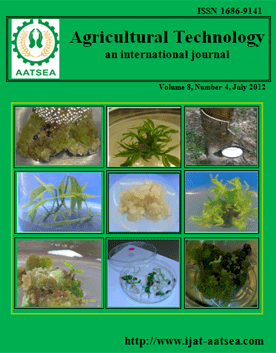ThaiScience
ThaiScience
INTERNATIONAL JOURNAL OF AGRICULTURAL TECHNOLOGY
Volume 15, No. 02, Month MARCH, Year 2019, Pages 261 - 272
Spatial variability in soil water under adjacent mature oil palm and rubber plantations: application of a new dielectric method in evaluating soil water
Hermawan, B., Suhartoyo, H., Anandyawati, Sukisno, Gonggo, B., Hasanudin and Agustian, I.
Abstract Download PDF
Many people have commonly addressed that oil palm plantations release much more water from the ground by evapotranspiration compared to other crops. The current research evaluated the spatial variability in soil water content under adjacent oil palm and rubber plantations established in 2005 and 1995, respectively. We collected ten pairs of soil electrical impedance data (Z, in kΩ) from the oil palm and rubber sites using a newly-developed electrical impedance meter, then converted to soil water content (θ, in g.g-1) using the equation of θ = 0.45.Z-0.2. The impedance measurements took place at 0-10 and 10-20 soil depths to allow the comparisons of actual soil wetness between the two crops at the rooting zones. At the same time, we also collected disturbed soil samples from the measurement points for the laboratory determination of soil water using the standard gravimetric method. Results showed that soils under oil palm plantation were consistently more wet than under rubber in all pairs of measurements. At the 0-10 cm depth, the average soil water content at the time of measurements was 0.04 g.g-1 higher for oil palm than for rubber. The field water content ranged from 0.310 to 0.384 and 0.268 to 0.318 g.g-1 for oil palm and rubber, respectively. The standard deviations of samples were about 0.02 g.g-1 for both crops indicating the statistical confidence that the oil palm site contained more water than the rubber site. Similar trends were found at the 10-20 cm soil depth suggesting the consistent benefit of the oil palm plantation in preserving soil water in the 0-20 cm rooting zone. Results in soil water variability gained from the dielectric method were similar to those obtained using the standard gravimetric method.
Keywords
Electrical impedance, oil palm, rubber, soil waterINTERNATIONAL JOURNAL OF AGRICULTURAL TECHNOLOGY
Published by : Association of Agricultural Technology in Southeast Asia (AATSEA)
Contributions welcome at : http://www.ijat-aatsea.com
